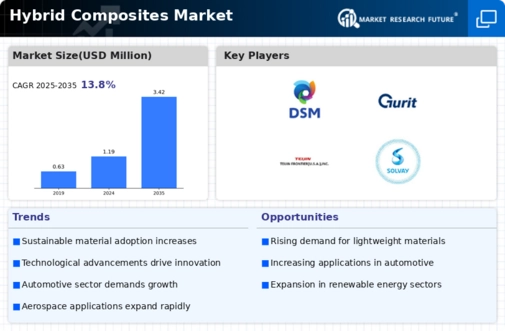Market Share
Hybrid Composites Market Share Analysis
In the ever-evolving landscape of the Hybrid Composites Market, companies deploy diverse market share positioning strategies to carve out a competitive niche and gain prominence. One pivotal strategy is differentiation, where companies focus on producing hybrid composites with unique combinations of materials, tailored for specific applications or industries. By investing in research and development, companies can create innovative formulations that offer superior strength, lightweight properties, or other specialized features, attracting customers seeking advanced solutions. This differentiation not only distinguishes companies from competitors but also secures a notable market share by meeting the evolving demands of industries such as automotive, aerospace, and construction.
Cost leadership is another crucial strategy in the Hybrid Composites Market. This approach centers on becoming a low-cost producer through efficient manufacturing processes, economies of scale, and effective supply chain management. Emphasizing cost efficiency enables companies to offer competitive pricing for their hybrid composites, making them attractive to cost-conscious industries and ultimately gaining a larger market share. Successful execution of this strategy demands continuous improvement, innovative production methods, and a sharp focus on operational excellence to maintain profitability while providing cost-competitive products.
Strategic alliances and partnerships play a vital role in shaping the market share positioning of companies in the Hybrid Composites Market. Collaborating with key stakeholders such as raw material suppliers, research institutions, or end-user industries allows companies to access essential resources, technologies, and distribution channels. Through strategic partnerships, companies can expand their market reach, leverage shared expertise, and create synergies that enhance their overall competitive position. This collaborative approach fosters innovation, accelerates market penetration, and contributes to a more robust market presence.
Geographical expansion is a strategic imperative for companies aiming to increase their market share in the Hybrid Composites Market. Identifying and entering new markets or expanding existing operations globally allows companies to tap into regions with growing demand for advanced composite materials. Adapting products to suit the unique requirements of different markets is crucial for success in geographical expansion. This strategy enables companies to diversify their customer base, reduce dependency on specific regions, and strengthen their market share on a global scale.
Furthermore, a customer-centric approach is vital for gaining and maintaining market share in the Hybrid Composites Market. Understanding customer requirements, providing technical support, and offering excellent customer service contribute to building strong relationships. Companies that prioritize customer satisfaction often benefit from increased loyalty, positive word-of-mouth marketing, and repeat business, ultimately solidifying their market share. As industries increasingly turn to hybrid composites for lightweight, high-strength solutions, aligning products with customer needs becomes a cornerstone for sustained success.







Leave a Comment